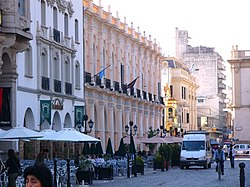Región Noroeste Argentino
The region of Noroeste Argentino (NOA) is a major Argentine region. It covers the northwest of the country. Since 1999 it has been merged with the Región Noreste Argentino to form the so-called Región Norte Grande . The negotiations on this are not yet fully completed, but extensive cooperation is already taking place, particularly in the business world.
For geographical reasons, the province of La Rioja is included in the north-west region in some sources , but it does not take part in the integration process in the Región Norte Grande.
structure
The following provinces are included in this region:
Important cities
The most important cities are San Miguel de Tucumán (750,000 inhabitants), the center of the sugar and heavy industry, Salta (480,000 inhabitants), a tourist center, the agro-industrial Santiago del Estero (360,000 inhabitants) and the metropolis of the steel and petroleum industry, San Salvador de Jujuy (320,000 inhabitants).
geography
The region can be divided into four zones from west to east;
- the Andes with the Puna plateau, which have a very dry climate in the region and are characterized by a grass steppe
- the high valleys , which run north-south in the east and south-east of the Puna and have the character of oases.
- the subtropical rainforests that cover a narrow strip between Tucumán and northern Salta.
- the Gran Chaco plain , which adjoins the rainforests to the east and is a savannah-like thorn bush forest with wide grass plains.
To the southeast of these regions, in the provinces of Tucumán, Catamarca and La Rioja, lie the Sierras Pampeanas , dry low mountain ranges covered by the Monte Bush forest.
economy
The main branches of economy are tropical and subtropical agriculture (tobacco and sugar cane cultivation in Tucumán and in the east of Salta and Jujuy), petroleum extraction in the northeast of Jujuy and Salta, heavy industry (steel in Jujuy, automotive industry in Tucumán) and, to an ever lesser extent, mining (El Aguilar in Jujuy).
With the exception of the comparatively affluent Salta, all the provinces of the NOA are among the poorest in Argentina; the overpopulated province of Tucumán, which is suffering from a long economic crisis as a result of the decline in sugar cane cultivation, is particularly hard hit, where malnutrition is a serious problem and around 20% of all children are under 5 years. In many rural areas, unemployment is over 50%.
Corredor Bioceánico
The provinces of the NOA and NEA place their hopes above all in trade, and in particular in the Corredor Bioceánico project (Spanish for two-ocean corridor), a cross-connection between northern Chile and Brazil, which runs through the entire Norte Grande region and the most northerly east-west connection through South America, which is navigable all year round - in Bolivia, Paraguay and Brazil there are currently only cross connections via difficult-to-drive earth roads. The region is hoping for economic impetus from this important trade route.
The most important connections of the Corredor Bioceánico are the highways Ruta Nacional 16 between the city of Metán (Salta) and Resistencia and the Ruta Nacional 81, which is about to be completed, between General Ballivián (Salta) and Formosa .
tourism
Tourism in the region is on the upswing due to the diverse landscape types and the many old colonial towns in the region. Particularly attractive destinations are the Quebrada de Humahuaca in Jujuy, a colorful gorge with historical buildings, the city of Salta with its colonial buildings and the El Rey , Calilegua and Baritú national parks .

